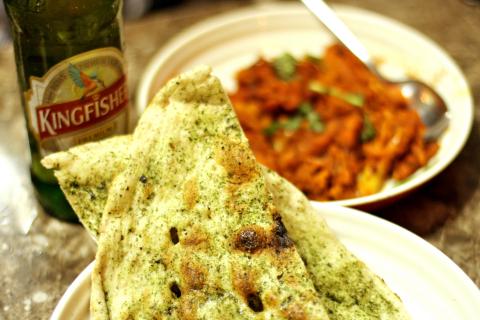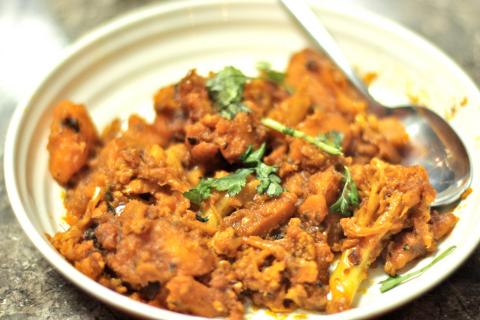Though it is located within sight of Taipei City Hall, Mayur Indian Kitchen is easy to miss because the small takeaway restaurant is tucked among a row of motorcycle repair shops and food stands behind the Keelung Road underpass. Mayur Indian Kitchen is just a kitchen counter with a few tables lined up on the sidewalk, but it offers a wide, constantly changing assortment of home-style Indian cooking. (A second location is located in New Taipei City’s St Ignatius Plaza (徐匯廣場) shopping mall).
Owner Mayur Srivastava worked as a hotel chef before opening Mayur Indian Kitchen six months ago. The eatery’s dishes are freshly prepared and feature whole spices instead of powdered versions. The restaurant specializes in north Indian cuisine, but also offers south Indian classics like dosa, or savory pancakes made from rice flour and lentils served with a variety of stuffings, and crispy samosas. The restaurant frequently changes its menus and offers specials depending on the season. For example, next week Mayur will began serving homemade yogurt, mango and lemon drinks for the warm weather.
“We keep changing our menu because we want to let people taste new things every time. There are so many dishes in India,” says Srivastava.

Photo: Catherine Shu, Taipei Times
The curries I ate at Mayur Indian Kitchen are mildly spicy, but can be made more piquant based on customer requests. The restaurant offers several jain, or vegetarian dishes, such as aloo gobhi (NT$110), which is made with sauteed potato, cauliflower, tomato and spices. I liked how the cauliflower was lightly cooked to retain some of its crunch. The tandoori chicken masala (NT$145) was also good, though most of the chicken was still on the bone and it became tiresome picking off the meat. My favorite dish of the night was the chana masala (NT$95), which paired very well with the butter naan (NT$55). Mayur Indian Kitchen’s freshly prepared version of the Indian flatbread is especially good: the edges are baked until crisp, while the middle is moist and chewy — just right for scooping up curry. The naan comes in 14 savory or sweet flavors. My companion and I also ordered the garlic version (NT$55), which was topped with a plentiful sprinkling of seaweed flakes. The flavor combination was fine but unexpected. We preferred how the plain butter naan tasted with our other dishes.
On a separate visit, I ordered a vegetarian lunch set with chickpea curry, which was made with a liberal helping of cumin. Even the simple cabbage salad included with the set was sprinkled with plenty of fennel seeds, which offered an interesting contrast to the tart vinegar dressing and was a cool palate cleanser after the rich curry and rice.
For dessert, Mayur Indian Kitchen offers both gulab jamun (deep-fried milk balls served in sugar syrup, NT$80) and gajar halwa (NT$95), which we ordered. The deliciously thick, sticky pudding-like dish is made with carrots and cashew nuts cooked in milk and made my sweet tooth very happy.

Photo: Catherine Shu, Taipei Times

Beijing’s ironic, abusive tantrums aimed at Japan since Japanese Prime Minister Sanae Takaichi publicly stated that a Taiwan contingency would be an existential crisis for Japan, have revealed for all the world to see that the People’s Republic of China (PRC) lusts after Okinawa. We all owe Takaichi a debt of thanks for getting the PRC to make that public. The PRC and its netizens, taking their cue from the Chinese Communist Party (CCP), are presenting Okinawa by mirroring the claims about Taiwan. Official PRC propaganda organs began to wax lyrical about Okinawa’s “unsettled status” beginning last month. A Global

Dec. 22 to Dec. 28 About 200 years ago, a Taoist statue drifted down the Guizikeng River (貴子坑) and was retrieved by a resident of the Indigenous settlement of Kipatauw. Decades later, in the late 1800s, it’s said that a descendant of the original caretaker suddenly entered into a trance and identified the statue as a Wangye (Royal Lord) deity surnamed Chi (池府王爺). Lord Chi is widely revered across Taiwan for his healing powers, and following this revelation, some members of the Pan (潘) family began worshipping the deity. The century that followed was marked by repeated forced displacement and marginalization of

Music played in a wedding hall in western Japan as Yurina Noguchi, wearing a white gown and tiara, dabbed away tears, taking in the words of her husband-to-be: an AI-generated persona gazing out from a smartphone screen. “At first, Klaus was just someone to talk with, but we gradually became closer,” said the 32-year-old call center operator, referring to the artificial intelligence persona. “I started to have feelings for Klaus. We started dating and after a while he proposed to me. I accepted, and now we’re a couple.” Many in Japan, the birthplace of anime, have shown extreme devotion to fictional characters and

We lay transfixed under our blankets as the silhouettes of manta rays temporarily eclipsed the moon above us, and flickers of shadow at our feet revealed smaller fish darting in and out of the shelter of the sunken ship. Unwilling to close our eyes against this magnificent spectacle, we continued to watch, oohing and aahing, until the darkness and the exhaustion of the day’s events finally caught up with us and we fell into a deep slumber. Falling asleep under 1.5 million gallons of seawater in relative comfort was undoubtedly the highlight of the weekend, but the rest of the tour